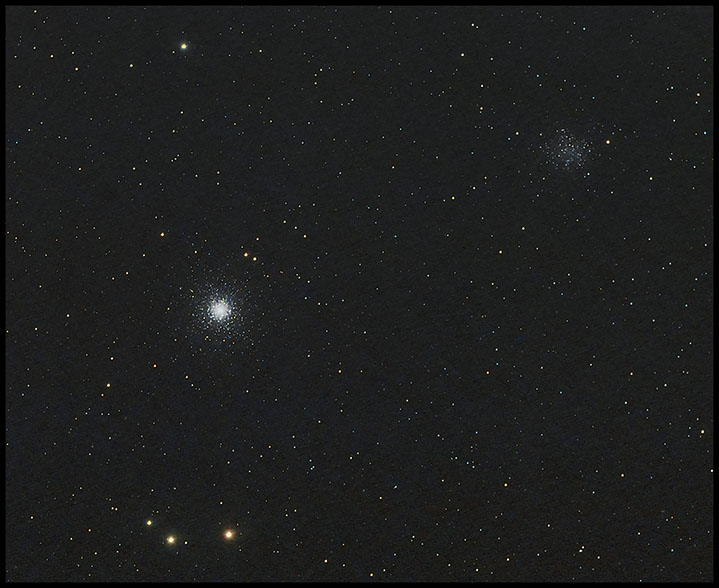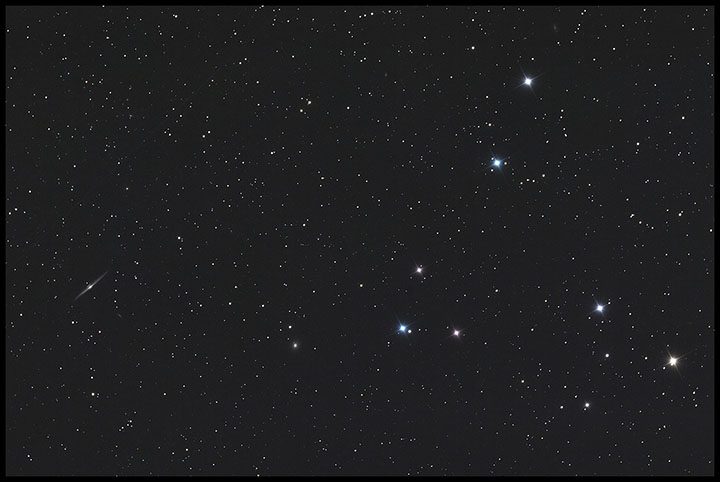For Richer, For Poorer...
Three clusters, one evening.
6/10/2016. The polar alignment and PEC refresh seemed very effective. I saw no corrections of more than 1 arcsecond during two hours-long sets of exposures tonight while I used the AT65EDQ for some widefield photos. A growing Moon not so far away? Piffle.
First, by way of a preview, here is a tightly cropped view of M53 and NGC 5053, a rich globular cluster and a relatively impoverished one side by side in Coma Berenices. Resolution toward the center of M53 fails in the small 'scope. The field shown in the little image below is cropped to the approximate composition that the 10-inch F4 would provide. I think it will be well worth giving the Newtonian a shot at this. Click the image for the widefield view (at reduced resolution for the web).

M53 & NGC 5053
30x180s (1hr 30m)
AT65EDQ / Canon 6D
/ ISO 1600
Click for a w-i-d-e-r view.
Still sparser are the stars of the Coma Star Cluster, a nearby open cluster that provides a foreground for an edge-on galaxy (NGC 4565):

The Coma Star Cluster with NGC 4565 (lower left)
15x180s (45 min)
AT65EDQ / Canon 6D
/ ISO 1600
Worth clicking the image!
Why, yes, I did sweeten the cluster stars with a judicious pass of StarSpikes Pro. Otherwise, they just don't stand out in the photo the way they do at the eyepiece. The star cluster is ~225 light-years away, the galaxy more like 46,000,000 light-years. There's a lot of space in space.
I finished the night by shooting 5-minute darks. These 3-minute subs are about all I can do with relatively fast glass from the back yard, but who knows? With the 10-inch RC, or on some crisp night with the AT65EDQ, or on any getaway to the Parkway, longer subs could be useful.
6/13/2016. I decided to re-measure the mount's periodic error using the 442mm FL AT65EDQ. It's a hazy, hot, humid, Moony evening. Did I mention buggy? That too.
Consider this your esoteric zeroeth world concern trigger warning. The R.A. drive motor worked its way loose and slipped several teeth on the drive gear. That spoiled both the factory-loaded periodic error correction curve I've been using (?) for some years as well as the curve I built a few nights ago. When I remeasured the native precision of the mechanical pieces (that is, the drive accuracy without any PEC compensation curve), I found a peak to peak periodic error of +3.4/-3.6 arcseconds with an RMS of (look it up) arcseconds. Not bad, but just within A-P's specs for this mount. I had PEMpro watch three rotations of the worm gear and build a new curve using all the fundamental periods that contributed more than 0.1 arcsecond of total error, loaded it, power-cycled the mount, and retested: RMS 0.54 arcseconds with a peak to peak error of 1.65 arcseconds (+0.8/-0.8) arcseconds. That's the way it's supposed to work! (Assuming I'm reading the various graphs correctly.)
Tips: Use a longish exposure for PEC measurements. Otherwise you're measuring seeing. One second worked well, much better than 0.1 did. Power off and back on after uploading the new curve just to be sure everything re-initializes as you expect. And have I even been using PEC all this time? My handset was set to PEC "none" rather than PEC "play." ("Tools" menu, first item.)
Next time: Run "Calibration" first. It should save a ton of trial and error.
6/16/2016. More Tips After "Next time": Use a fainter star and keep the peak brightness under 16k, whcih is apparently saturation. As you well know, using saturated stars makes finding the centroid position questionable. Adjust exposure to produce a peak brightness around 11-14k.
For some reason, I had to invert the curve tonight. Did I calibrate on one side of the meridian and take data on the other? That flips the camera. Or maybe I did something peculiar-er. IS power cycling necessary? Probably not.
I measured a fairly grisly PE tonight. 12-14" peak to peak, and essentially all of it was associated with the rotation period of the worm, not the reduction gears. There is also a slow drift in RA. Did I mesh it too tightly? Is it binding or dragging for half the rotation? That's what it looks like. Nevertheless, a PEC curve built from 3 rotations knocked the error down to 3-4 arc seconds. We can do better.
When turning off PEC for measurement: if you want to be paranoid and thorough, turn it off in PEMPro; make sure PEM is set to "none" in the handset's "Tools" dialog; disable it in ASCOM. Per a discussion I found on the 'Tubes between a user and PEMPro author Ray Gralak. Imbalance and a too-tight mesh were cited as possible issues that would produce bad PE's and secular drift. Also polar misalignment, which I do not think is an issue here.
6/16/2016. Went outside to loosen the gear mesh. Found the mesh plenty loose already. Tightened it instead. Then checked balance. The counterweight bar extension weighs more than you think it does. The (tiny) AT65EDQ was way overbalanced by the arrangement I've been using. I removed the extenstion and moved the counterweight up to within an inch or two of the top of the stubby bar. Clouds in the forecast, but I am anxious to retry this.